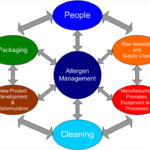Effective employee training is a cornerstone of risk management strategies in the food industry, particularly when it comes to food insurance. Training equips staff with the knowledge and skills necessary to manage risks, ensure compliance, and uphold food safety standards, ultimately protecting the business from potential losses and insurance claims. This article explores the importance of employee training in risk management, key components of a training program, and best practices for implementation.
1. Importance of Employee Training in Risk Management
1.1 Enhancing Food Safety
Food safety is paramount in the food industry. Proper training ensures that employees are aware of and adhere to food safety practices, reducing the risk of contamination and foodborne illnesses. This includes understanding hygiene standards, proper handling of food, and awareness of allergens and dietary restrictions.
1.2 Minimizing Risk of Insurance Claims
Training helps mitigate risks that could lead to insurance claims. By educating employees on best practices and regulatory requirements, businesses can prevent incidents that might result in claims, such as contamination, spoilage, or safety violations.
1.3 Ensuring Compliance
Regulatory compliance is crucial for avoiding legal issues and maintaining operational licenses. Training programs ensure that employees understand and comply with relevant food safety regulations, industry standards, and company policies, thereby reducing the risk of non-compliance and associated penalties.
1.4 Promoting a Safety Culture
A strong safety culture within a company fosters an environment where employees are proactive about risk management. Training helps instill a sense of responsibility and vigilance, encouraging employees to identify and address potential risks before they escalate.
1.5 Improving Operational Efficiency
Well-trained employees are more competent and efficient in their roles, leading to smoother operations and fewer errors. This enhances overall operational efficiency and reduces the likelihood of incidents that could impact food safety and insurance coverage.
2. Key Components of an Effective Training Program
2.1 Training Needs Assessment
2.1.1 Identifying Gaps
Before developing a training program, it’s essential to assess the specific needs of the organization. This involves identifying gaps in current practices, understanding regulatory requirements, and evaluating the risk areas that require focus.
2.1.2 Setting Objectives
Define clear objectives for the training program based on the identified needs. Objectives might include improving knowledge of food safety standards, enhancing awareness of risk management procedures, or ensuring compliance with legal requirements.
2.2 Development of Training Materials
2.2.1 Content Creation
Develop training materials that are relevant and comprehensive. This includes:
- Food Safety Protocols: Detailed information on food safety practices, including hygiene, handling, and storage.
- Risk Management Procedures: Guidelines on how to identify, assess, and manage risks.
- Regulatory Compliance: Information on relevant regulations and industry standards.
2.2.2 Format and Delivery
Choose appropriate formats and delivery methods for the training materials. Options include:
- In-Person Workshops: Interactive sessions led by experts, allowing for hands-on learning and immediate feedback.
- Online Training: E-learning modules that provide flexibility and can be accessed remotely.
- Printed Materials: Manuals, guides, and posters that employees can reference as needed.
2.3 Training Implementation
2.3.1 Scheduling and Participation
Plan the training schedule to ensure maximum participation. Consider the following:
- Frequency: Regularly scheduled training sessions to keep employees updated on new practices and regulations.
- Attendance: Ensure that all relevant employees, including new hires and existing staff, participate in the training.
2.3.2 Delivery and Engagement
Deliver the training in an engaging and effective manner. This might include:
- Interactive Activities: Use case studies, role-playing, and simulations to make the training more engaging.
- Assessments: Implement quizzes and assessments to evaluate understanding and reinforce learning.
2.4 Evaluation and Feedback
2.4.1 Measuring Effectiveness
Assess the effectiveness of the training program through various methods, such as:
- Pre- and Post-Training Assessments: Measure knowledge before and after the training to gauge improvements.
- Employee Feedback: Collect feedback from employees to identify areas for improvement.
2.4.2 Continuous Improvement
Use the evaluation results to make necessary adjustments to the training program. Continuously update training materials to reflect changes in regulations, industry standards, and best practices.
3. Best Practices for Implementing Employee Training
3.1 Integration into Onboarding
3.1.1 Comprehensive Onboarding
Incorporate risk management training into the onboarding process for new employees. Ensure that they receive thorough instruction on food safety protocols, risk management procedures, and compliance requirements from the outset.
3.1.2 Ongoing Training
Provide ongoing training opportunities for new employees as part of their development. This helps reinforce key concepts and ensures that they remain up-to-date with the latest practices and regulations.
3.2 Emphasizing Practical Application
3.2.1 Hands-On Training
Incorporate practical, hands-on training activities to reinforce theoretical knowledge. This might include:
- Simulated Scenarios: Practice managing hypothetical risk situations to build problem-solving skills.
- Real-Life Case Studies: Analyze past incidents to understand what went wrong and how to prevent similar issues.
3.2.2 Job Aids
Provide job aids, such as checklists and guidelines, to help employees apply what they have learned in their daily tasks. These aids serve as quick references and reinforce training concepts.
3.3 Encouraging a Culture of Continuous Learning
3.3.1 Regular Updates
Keep employees informed about changes in regulations, industry standards, and company policies. Provide updates and refresher courses to ensure that knowledge remains current.
3.3.2 Professional Development
Encourage employees to pursue additional training and certification related to food safety and risk management. Support their professional development to enhance their skills and expertise.
3.4 Leveraging Technology
3.4.1 E-Learning Platforms
Utilize e-learning platforms to provide accessible and flexible training options. Online courses can be tailored to specific needs and made available to employees at their convenience.
3.4.2 Mobile Learning
Implement mobile learning solutions that allow employees to access training materials and resources via smartphones and tablets. This ensures that training is available on-the-go and can be accessed as needed.
3.5 Measuring and Recognizing Success
3.5.1 Tracking Performance
Monitor employee performance and track the effectiveness of the training program. Use performance metrics and key performance indicators (KPIs) to assess the impact of training on risk management and compliance.
3.5.2 Recognizing Achievements
Acknowledge and reward employees who demonstrate exceptional understanding and application of risk management practices. Recognition can boost morale and reinforce the importance of adhering to risk management protocols.
4. Conclusion
Employee training is a vital component of risk management strategies in food insurance. By equipping staff with the necessary knowledge and skills, businesses can enhance food safety, minimize the risk of insurance claims, ensure regulatory compliance, and foster a culture of safety and continuous improvement. Effective training programs include a thorough needs assessment, development of relevant materials, engaging implementation, and ongoing evaluation. Best practices, such as integrating training into onboarding, emphasizing practical application, and leveraging technology, further support successful risk management. Ultimately, a well-trained workforce contributes to operational excellence, risk reduction, and the overall success of food businesses.



